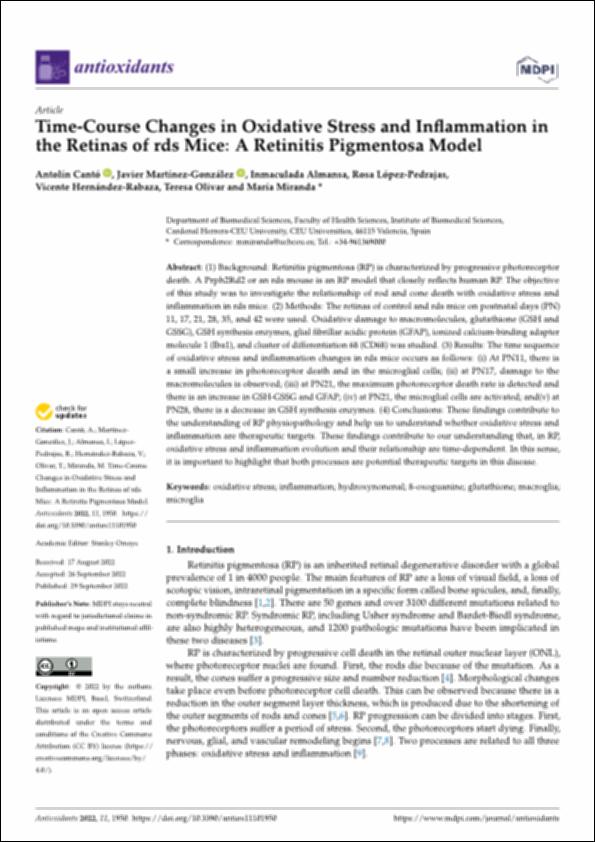Por favor, use este identificador para citar o enlazar este ítem:
http://hdl.handle.net/10637/14191Time-course changes in oxidative stress and inflammation in the retinas of rds mice a retinitis pigmentosa model
| Título : | Time-course changes in oxidative stress and inflammation in the retinas of rds mice a retinitis pigmentosa model |
| Autor : | Cantó Catalá, Antolín Martínez González, Javier Almansa Frías, María Inmaculada López Pedrajas, Rosa María Hernández Rabaza, Vicente Olivar Rivas, Teresa Miranda Sanz, María |
| Materias: | Retina - Diseases - Treatment.; Retinitis pigmentaria - Tratamiento.; Estrés oxidativo - Tratamiento.; Glutatión - Uso terapéutico.; Retina - Enfermedades - Tratamiento.; Oxidative stress - Treatment.; Retinitis pigmentosa - Treatment.; Hemodialysis.; Exercise - Computer simulation.; Glutathione - Therapeutic use. |
| Editorial : | MDPI |
| Citación : | Cantó, A., Martínez-González, J., Almansa, I., López-Pedrajas, R., Hernández-Rabaza, V., Olivar, T. & Miranda, M. (2022). Time-course changes in oxidative stress and inflammation in the retinas of rds mice: a retinitis pigmentosa model. Antioxidants, vol. 11, i. 10 (29 sep.), art. 1950. DOI: https://doi.org/10.3390/antiox11101950 |
| Resumen : | (1) Background: Retinitis pigmentosa (RP) is characterized by progressive photoreceptor death. A Prph2Rd2 or an rds mouse is an RP model that closely reflects human RP. The objective of this study was to investigate the relationship of rod and cone death with oxidative stress and inflammation in rds mice. (2) Methods: The retinas of control and rds mice on postnatal days (PN) 11, 17, 21, 28, 35, and 42 were used. Oxidative damage to macromolecules, glutathione (GSH and GSSG), GSH synthesis enzymes, glial fibrillar acidic protein (GFAP), ionized calcium-binding adapter molecule 1 (Iba1), and cluster of differentiation 68 (CD68) was studied. (3) Results: The time sequence of oxidative stress and inflammation changes in rds mice occurs as follows: (i) At PN11, there is a small increase in photoreceptor death and in the microglial cells; (ii) at PN17, damage to the macromolecules is observed; (iii) at PN21, the maximum photoreceptor death rate is detected and there is an increase in GSH-GSSG and GFAP; (iv) at PN21, the microglial cells are activated; and(v) at PN28, there is a decrease in GSH synthesis enzymes. (4) Conclusions: These findings contribute to the understanding of RP physiopathology and help us to understand whether oxidative stress and inflammation are therapeutic targets. These findings contribute to our understanding that, in RP, oxidative stress and inflammation evolution and their relationship are time-dependent. In this sense, it is important to highlight that both processes are potential therapeutic targets in this disease. |
| Descripción : | Este artículo se encuentra disponible en la siguiente URL: https://www.mdpi.com/2076-3921/11/10/1950 Este artículo de investigación pertenece al número especial "Retinal Diseases Associated with Oxidative Stress: Advances in Pathophysiology and Therapeutic Approaches". |
| URI : | http://hdl.handle.net/10637/14191 |
| Derechos: | http://creativecommons.org/licenses/by/4.0/deed.es |
| ISSN : | 2076-3921 (Electrónico) |
| Idioma: | es |
| Fecha de publicación : | 29-sep-2022 |
| Centro : | Universidad Cardenal Herrera-CEU |
| Aparece en las colecciones: | Dpto. Ciencias Biomédicas |
Los ítems de DSpace están protegidos por copyright, con todos los derechos reservados, a menos que se indique lo contrario.


